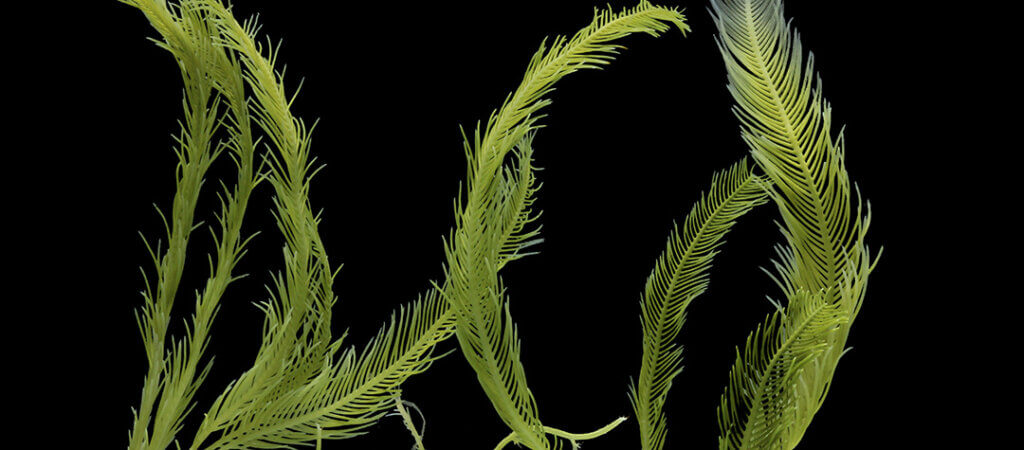Caulerpa: The Invasive Seaweed Species Spreading along California’s Coastline
Caulerpa is a type of green seaweed native to many shallow tropical and subtropical waters around the world. In the U.S., some species of Caulerpa occur naturally in tropical waters off the coast of Florida and North Carolina. Caulerpa seaweeds are also commonly used in saltwater aquariums around the world. However, Caulerpa seaweeds can withstand a broad range of environmental conditions, making them highly invasive when they are introduced to new areas. Once introduced, Caulerpa can smother native marine life, such as seagrasses, which can cause ripple effects in marine food webs.
With infestations of Caulerpa on the rise in California, environmental regulatory agencies are now requiring Caulerpa surveys prior to the start of in-water work. Because Caulerpa can spread easily when fragmented, pre-construction surveys serve to ensure Caulerpa is not inadvertently spread during marine construction. Agencies typically require all Caulerpa surveys to be performed by certified surveyors, who must take a test via the National Oceanic and Atmospheric Administration (NOAA) to obtain certification. WRA is proud to have two certified Caulerpa surveyors on our staff, marine biologists Liz Allen and Bailey McCann. More information on the certification process and how to enlist WRA for your Caulerpa survey needs is provided below.
Caulerpa in California
While California is home to many different types of seaweeds, there are no native species of Caulerpa. As such, Caulerpa is considered invasive throughout the state. Two different species of Caulerpa have been detected in California: C. taxifolia and C. prolifera. Both species can rapidly colonize new areas from small fragments and have the potential to cause substantial negative impacts on native ecosystems.
Caulerpa was first discovered in Southern California’s Agua Hedionda Lagoon and Huntington Harbour in 2000 as two separate, small infestations. Together, these two infestations are the first known occurrences of the C. taxifolia in North America. Despite early detection of these two Caulerpa invasions, eradication efforts took six years and cost about $7 million while causing serious damage to native eelgrasses (Zostera marina and Z. japonica).
During the eradication process, the Southern California Caulerpa Action Team (SCCAT) was formed. This team is made up of federal, state, and local governmental agencies, scientists, consultants, and local stakeholders including the Regional Water Quality Control Board, State Water Resources Control Board, California Coastal Commission, NOAA’s National Marine Fisheries Service (NMFS), the U.S. Fish and Wildlife Service, and the City and Port of San Diego. In September 2001, Assembly Bill 1334 was enacted by the State of California banning the transport, sale, and possession of nine potentially invasive species of Caulerpa Statewide, including C. taxifolia.
A different species of Caulerpa, C. prolifera, was discovered in April 2021 in Newport Bay’s China Cove. A second population C. prolifera was discovered in September 2023 at Coronado Cays in San Diego Bay. In response to the first detection of C. prolifera, the SCCAT reconvened and implemented eradication efforts shortly thereafter. Eradication efforts at both sites is ongoing. In addition, in July 2023, Governor Newsom signed Assembly Bill 655 into law, expanding the statewide ban to all Caulerpa species, including C. prolifera, except for scientific research purposes.
Caulerpa Control Protocol
The SCCAT developed the Caulerpa Control Protocol to detect existing infestations and avoid the spread of these invasive species to other systems. NMFS and the California Department of Fish and Wildlife (CDFW) serve as the lead Federal and State agencies, respectively, for administering the Caulerpa Control Protocol. The Protocol outlines surveyor certification requirements, allowable survey methods for different situations, and reporting guidelines required when surveying for Caulerpa in California. These guidelines apply to any bottom disturbing activities (e.g., pile driving, dredging, etc.) between Morro Bay and the U.S./Mexico border as these activities have the potential to fragment and spread Caulerpa. Surveys should occur between March 1 and October 31 when Caulerpa growth peaks.
Before conducting a Caulerpa survey, surveyors must be certified by NMFS or CDFW by passing an exam that demonstrates an understanding of the Caulerpa Control Protocol and the ability to identify all Caulerpa species.
We’re Here to Help!
WRA’s certified Caulerpa surveyors, marine biologists Liz Allen and Bailey McCann, have each completed surveys for Caulerpa to meet agency requirements. Over the last two decades, WRA biologists have performed more than 40 subaquatic vegetation surveys to support a variety of project types. With our breadth of experience, WRA’s biologists are attuned to both regional trends in marine ecology and the latest expectations of regulatory agencies, such as NMFS and CDFW.
Whether you’re planning a shoreline re-development project or looking into nature-based solutions for shoreline protection, WRA biologists are ready to provide input on whether Caulerpa may be a factor for your project planning.
To learn more about WRA’s services or to request a survey, please contact Liz Allen or submit a request through WRA’s contact page.
WRA Contact:

Liz Allen
liz.allen@wra-ca.com




